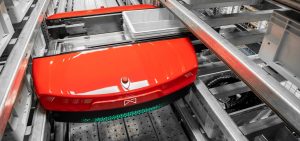Challenges in ASRS Implementation: How Do We Navigate Them?
ASRS has revolutionized the way warehouses work. With the increased cost of real estate and human labor, Automated Storage and Retrieval Systems (ASRS) allow for storing more items in a smaller footprint with less labor cost and higher efficiency.
Yet, it comes with its own set of challenges. These include high initial costs, space constraints, system complexity, integration with existing infrastructure, and the need for skilled personnel. Therefore, this blog will talk about taking a strategic approach to navigating these obstacles. Dive into the chapters below to find out how to do that!

△Why is ASRS Important?
▲What is ASRS?
Automated Storage and Retrieval Systems refer to a modern technology that enables automatic material handling in a warehouse. It utilizes computer-managed machines and software systems to move products between storage locations and picking areas through a system of storage racks, conveyors, and robotic cranes.
▲What are the Benefits of ASRS?
- ASRS (Automated Storage and Retrieval Systems) speeds up picking, packing, and storing tasks, saving time and resources.
- It maximizes vertical space, which is ideal for warehouses with limited square footage.
- It minimizes human errors in inventory management, leading to more accurate order fulfillment.
- It reduces the risk of accidents by automating heavy lifting and navigating hazardous areas.
- It provides valuable data on inventory movement, aiding in better decision-making and forecasting.
▲Is AS/RS Right for You?
①Volume Increases:If your inventory levels are growing rapidly, AS/RS can handle higher volumes efficiently.
②Space Constraints:When floor space is at a premium, AS/RS can utilize vertical space effectively.
③Accuracy Issues:If manual processes lead to frequent errors in inventory management, automation can improve accuracy.
④Labor Costs:When labor costs are high or difficult to manage, AS/RS can provide a cost-effective alternative.
⑤Order Fulfillment Speed:If you need to fulfill orders quickly and accurately, AS/RS can expedite the process.
⑥Employee Productivity:AS/RS frees up your employees to work on more valuable activities by relieving them of repetitive tasks.

△Understanding ASRS Implementation Challenges
There are some challenges to ASRS implementation in a warehouse. These challenges must be considered, and solutions must be developed to handle them appropriately.
▲Miscellaneous ASRS Options
An implementation challenge of ASRS is to pick a system that will be effective for the warehouse. There are many ASRS choices, each designed with different storage and retrieval mechanisms and sizes and weight ranges. It is important to critically assess the available alternatives and opt for the one that suits the specific requirements of your warehouse.
▲Complex ASRS Systems Integration
The integration of ASRS within the current warehouse systems can be quite challenging. ASRS depends on the integration of software, hardware, and mechanical components. Smooth integration of automated retrieval systems with the existing operations with minimal interruption calls for careful coordination through proper planning between the ASRS vendor and internal IT teams.
▲High Initial Investment
The high cost of the initial investment is one of the main problems that arise in the implementation of ASRS. ASRS systems require the installation of automated machinery, as well as alterations to infrastructure and software integration, all of which are expensive.
▲Staff Training and Adoption
ASRS warehouse will involve training the personnel to operate under the new system. This may be a problem, particularly for workers used to old-fashioned manual systems. Giving full training and support to the staff is essential to have a successful transfer and to benefit from the ASRS.
▲Limited Flexibility for Variable Operations
ASRS systems are supposed to work in an optimum manner under certain conditions. They may not be able to adapt to variable operations or sudden demand changes. It is important to consider the operational requirements of the warehouse and to determine whether the selected ASRS system can easily adjust to varying situations.
▲Machine Maintenance and Repair
ASRS systems are complex machinery and equipment that should be maintained regularly and repaired when necessary. The availability of qualified technicians and a good maintenance program are necessary to reduce downtime and increase system uptime.
△Best Practices to Ensure a Successful ASRS RollOut
Successful implementation of ASRS requires planning and execution. Best practices will help warehouses overcome the challenges and facilitate a seamless launching of the system.
▲Conduct a Thorough Analysis of ROI
Run a thorough return on investment (ROI) analysis before implementing ASRS to evaluate the system’s financial and non-financial benefits. Consider elements such as savings on labor costs, increased accuracy, and additional storage space.
▲Choose the Right ASRS technology.
Pick the ASRS technology most appropriate for your particular needs and demands. Evaluate aspects such as the category of products, order quantity, and warehouse design. Talking to the ASRS suppliers and experts will help in deciding.
▲Coordinate with ASRS Vendors on System Design
Work closely with professional ASRS vendors with systematic competence to customize a system for your warehouse’s needs. Ensure that the system design is seamless with the current warehouse systems and processes.
▲Prepare Equipment and Staff for ASRS Testing
Before the actual implementation, stage equipment and train staff for testing and trial runs. It will enable the discovery of any problems or modifications required prior to the full implementation.
▲Create a Robust ASRS Deployment Schedule
Develop a deployment schedule that allows for seamless integration of the ASRS system with minimal disruption to warehouse operations. Plan for contingencies and allocate sufficient time for testing, training, and troubleshooting.
▲Prepare Acceptance Test Strategies and Contingency Plans
Establish acceptance test strategies to ensure that the ASRS system meets the desired performance criteria. Additionally, develop contingency plans to address any unforeseen obstacles or challenges that may arise during the implementation process.
▲Implement Acceptance Test
Perform the acceptance test to validate that the ASRS system performs correctly. Evaluate process, quality, and system reliability during this stage.
▲Review and Adjust
Monitor the performance of the ASRS system post-implementation and modify it when required to enhance its efficiency and address any issues that may occur. The ongoing enhancement and supervision are the main factors in the pursuit of the most benefits from ASRS.

△HWArobotics: Your Experienced and Professional ASRS Provider
HWArobotics is a highly recommended supplier with extensive project experience in implementing Automated Storage and Retrieval Systems (ASRS). Our mini-load and pallet-load ASRS solutions are designed to specifically address the requirements of companies that handle pallets or small-sized goods in distribution centers or warehouses.
The Tote Shuttle Robot System, part of HWA Robotics’ ASRS offerings, automates the storage and retrieval process for small items or components. It consists of four major case-handling ASRS shuttle product lines, SLS300, SLS400, SLS500, and SLS600, for different product sizes and storage unit layouts. These systems streamline operations, reduce labor costs, and improve overall productivity.
Additionally, HWA Robotics offers the Pallet Shuttle Robot System, an advanced ASRS solution designed for the efficient handling and storage of pallets in warehouses or distribution centers. This system utilizes a specialized shuttle device that can move in four directions within the racking structure. Two major ASRS pallet shuttle product lines, FPSS1500A and FPSS1500B, can accommodate both room and cold temperature operations.
Overall, HWA Robotics’ solutions offer comprehensive automation for storage and retrieval processes, providing businesses with improved efficiency and cost savings.
You may also want to read more on ASRS implementation in the warehouse:
How to Enhance the Efficiency of E-Commerce Warehouse?
Buyer’s Guide: Single-Layer VS Double-Layer Sorting Station
△Conclusion
In conclusion, there are many advantages to installing ASRS in a warehouse, but there are drawbacks as well. By understanding these challenges and following best practices, organizations can navigate the complexities of ASRS implementation and achieve a successful rollout. Partnering with an experienced supplier like HWArobotics can further enhance the chances of a seamless and efficient implementation. Thus, if you’re thinking of using ASRS in your warehouse, make sure everything is in place for a seamless transition and enjoy the benefits of this cutting-edge technology.







